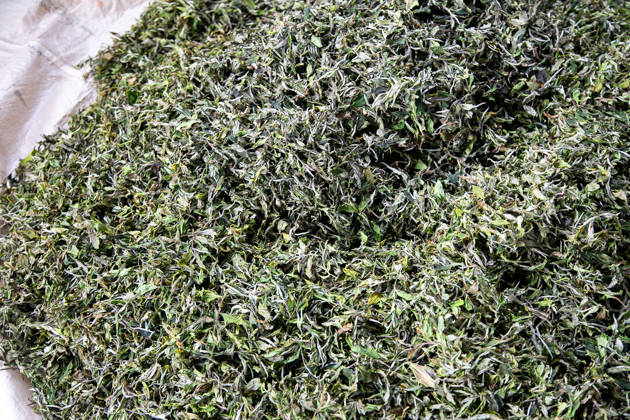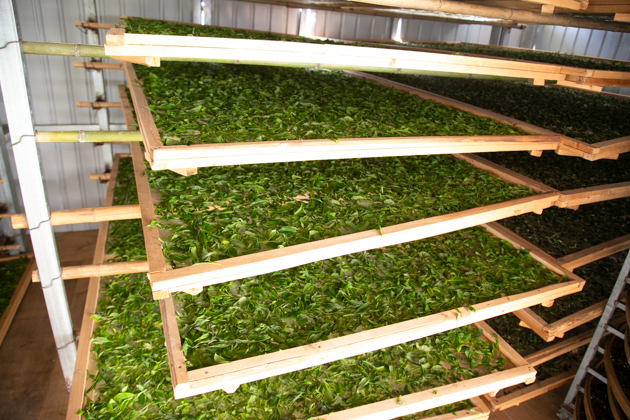- HOME >
- Types of Tea
2024 Overview: Our Yunnan White Tea Quality, Process, and Weather Insights
- [2024.05.13] Posted By Akira Hojo

One of the teas we’ve been focusing on in Yunnan Province is white tea. Historically white tea has been produced in both Fujian Province and Yunnan Province for a long time.
While white tea from Fujian Province is well-managed during processing, we are dissatisfied with the quality of the raw materials due to the use of fertilizers in conventional farming practices, resulting in a lack of aftertaste and flavor. Therefore, since around 2016, we’ve been making efforts to produce white tea in Yunnan Province.
Although white tea from Yunnan Province has high-quality raw materials, processing management has been challenging, often resulting in tea that resembles dried ear mushrooms.
However, through years of experience, we’ve improved our production methods and facilities, and in recent years, we’ve been able to produce white tea with excellent flavor and color.
Especially this year, the weather has been favorable throughout the entire production period of white tea, and we believe we’ve achieved very satisfactory results.

Scenery from the Local Primary Processing Plant
Quality is crucial due to the simplicity of the tea processing.
Making white tea is pretty straightforward. It mainly involves letting the tea leaves wither and dry. Unlike oolong or black tea, which undergo a lot of fermentation, white tea only goes through a light fermentation process as it withers.
Since the process is simple, the quality of the material is very important. If the tea leaves aren’t top-notch, it can be tough to get that full, rich flavor. Even though it looks good, the taste might not live up to expectations.
We focus on tea from Yunnan Province for a few reasons: the high altitude of over 2000 meters, the abundance of old trees aged between 100 and 500 years, and the agricultural practice of pesticide-free and fertilizer-free cultivation. These conditions allow the tea to grow slowly, develop rich flavors and aromas, and create a lingering aftertaste.


A Unique Production Method Unseen Elsewhere in Yunnan Province
Making white tea might seem straightforward, but mastering the withering technique demands various skills and careful attention to detail. Without handling the tea leaves precisely, the resulting white tea may not meet expectations.


We’ve drawn on our extensive experience in white tea production in Yunnan Province to ensure the best conditions for withering. This includes setting up facilities at the main production site in the mountains under our guidance. Additionally, we provide comprehensive training to local farmers in process management to ensure consistent production.
The Advantages and Disadvantages of Production Methods Without Any Artificial Heat

White tea production in Yunnan Province, unlike in Fujian Province where warm air is used, results in a delicate flavor profile. However, adverse weather conditions can significantly impact the final product. Continuous rain or high humidity can cause the disappearance of the top notes, known as “qingxiang” in Chinese, from white tea. To address this, we assign an ID to each tea garden and production day and conduct daily tastings of each batch to select only the finest lots.
We ensure to procure only the lots that meet our standards by paying higher prices than the standard selling price set by producers. Lots that are not selected are directed to other local tea buyers.
Maintaining Freshness Through Distribution Management
For white tea, once the tea passes the tasting test after production, it is immediately packaged in aluminum bags, sealed with a heat sealer, and exported promptly.

Previously, during the COVID-19 period, we relied entirely on producers to handle this process. However, this arrangement posed challenges, particularly during peak seasons when producers were overwhelmed with processing fresh tea leaves daily. Consequently, they could only pack the teas once the peak season subsided, resulting in shipping delays of over a month.
This year, we’ve taken on the packing process ourselves, we swiftly pack and ship the tea immediately after production. This proactive approach ensures quicker turnaround times, enabling us to deliver even fresher white tea than usual to our customers.
Related Articles
How to get the latest update on HOJO Tea?
1. Follow Twitter, 2. Click "Like" on Facebook, and 3. Subscribe in newsletter. You can have the latest tea news from HOJO Tea.
 Subscribe the Newsletter to enjoy the privileges
Subscribe the Newsletter to enjoy the privileges- You may receive a free sample upon purchase, or you may have the priority to purchase special products. So please remember to subscribe our newsletter as well as the social network.
- New Release of High Mountain White Tea
- We are pleased to introduce our High Mountain White Tea, sourced from a unique tea garden with two key features: 1. Located at an altitude of 2200-2300m2. Completely wild and untended The ideal natural conditions of this garden result in tea of exceptional quality, offering a pure and gentle, nourishing taste. High Altitude and Wild …
- New Release of Da Xue Shan Wild White Tea 2024
- We have released the 2024 Da Xue Shan Wild White Tea Loose Leaf. This tea was produced under our direct supervision during our stay in Yunnan Province, ensuring meticulous production management on site. Definition of Wild Tea in Yunnan Province People in Yunnan strongly associate Camellia taliensis with wild tea, regardless of where it is …
NEW ARTICLES
 Why Do Some Teas Taste Astringent? Exploring the Causes and Mechanisms of Astringency
Why Do Some Teas Taste Astringent? Exploring the Causes and Mechanisms of Astringency- Tea can range from having no noticeable astringency to possessing a very strong one. What causes this astringency? This article explores the causes and mechanisms behind astringency in tea. Causes of Astringency Astringency arises from the binding of tea components to proteins in the oral cavity, creating a sensation of tightness or dryness. The tongue …
 The Impact of Heat Sources on Tea Flavor
The Impact of Heat Sources on Tea Flavor- It is widely recognized that the material of a kettle plays an important role in shaping the taste of water for brewing tea. Yet, an often overlooked but equally significant factor is the type of heat source used to boil the water. Different heat sources, whether gas, electric, charcoal, or wood fire, can impart distinct …
 New Release of High Mountain White Tea
New Release of High Mountain White Tea- We are pleased to introduce our High Mountain White Tea, sourced from a unique tea garden with two key features: 1. Located at an altitude of 2200-2300m2. Completely wild and untended The ideal natural conditions of this garden result in tea of exceptional quality, offering a pure and gentle, nourishing taste. High Altitude and Wild …
 New Release of Da Xue Shan Wild White Tea 2024
New Release of Da Xue Shan Wild White Tea 2024- We have released the 2024 Da Xue Shan Wild White Tea Loose Leaf. This tea was produced under our direct supervision during our stay in Yunnan Province, ensuring meticulous production management on site. Definition of Wild Tea in Yunnan Province People in Yunnan strongly associate Camellia taliensis with wild tea, regardless of where it is …
 New Release of Wild Pu-erh Jasmine Pearl
New Release of Wild Pu-erh Jasmine Pearl- Out of curiosity, we decided to create a jasmine tea based on Da Xue Shan Wild Raw Tea. This resulted in an exceptionally rare tea, not only in Japan but also in China. Custom Production Network for Jasmine Tea At our store, we source various types of base teas from different regions during the spring. …
 2024 Overview: Our Yunnan White Tea Quality, Process, and Weather Insights
2024 Overview: Our Yunnan White Tea Quality, Process, and Weather Insights- One of the teas we’ve been focusing on in Yunnan Province is white tea. Historically white tea has been produced in both Fujian Province and Yunnan Province for a long time. While white tea from Fujian Province is well-managed during processing, we are dissatisfied with the quality of the raw materials due to the use …
 Yunnan’s Hospitality Culture: Expressed Through Meals
Yunnan’s Hospitality Culture: Expressed Through Meals- In China, as a form of greeting, it’s common to say “你吃饭了吗?” which means “Have you eaten?” However, in Yunnan Province, the phrase “吃饭” is often used in various situations, more like “Eat, eat,” serving as an invitation to share a meal. Yet, with prolonged exposure to Yunnan, one comes to understand that these meal …
 In Search of Wild Tea: Exploring Mountain Villages in Southwest Lincang, Yunnan
In Search of Wild Tea: Exploring Mountain Villages in Southwest Lincang, Yunnan- We are currently sourcing tea in the southwestern part of Lincang City, Yunnan Province. One of the crucial products for us is wild tea. While tea processing is important, securing the raw materials poses the biggest challenge. Recently, we received information about a new location where wild tea supposedly grows. To verify this, we visited …
 New Release of Anxi Traditional Oolong
New Release of Anxi Traditional Oolong- Anxi, located in Fujian province, China, is celebrated for its Tie Guan Yin tea. However, the Traditional Anxi Oolong from this region boasts a unique fruity aroma, distinguishing it from Tie Guan Yin. Anxi: A Renowned Hub for Oolong Tea Production in China Fujian Province, renowned for its rich tea heritage, boasts several prominent tea-producing …
 Yunnan 2024 Spring Tea Sourcing
Yunnan 2024 Spring Tea Sourcing- Yunnan Province is globally renowned for the exceptional quality of its tea leaves. However, lax production management often presents challenges in achieving the desired tea quality when relying solely on pre-made teas. To address this issue, we have committed to remaining on-site throughout the spring season to closely monitor tea production. We are meticulously inspecting …
Shop Info

Address:Lot No. T-215, 3rd Floor, The Gardens Mall, Mid Valley City, Lingkaran Syed Putra, 59200 Kuala Lumpur
Tel: +603-2287-4537
Business Hour: 10am to 10pm
Category
- New Arrival at HOJO Online Shop
- Featured Articles
- Newsletter
- Types of Tea
- Origin of Tea
- Teapot and Tea Equipment
- Tea Column
- How to enjoy tea
- Tea Processing
- How to choose quality tea
- Tea constituents and functional effect
- Safety of Tea
- Foods
- Tea Business Operation
- Hobby and Outdoor Activity
- Ranking of Tea
- Video
- FAQ
- Media Release
Profile

- AKIRA HOJO
- I invite you to experience my tea selections.I was born in Nagano, Japan. In university, I studied agricultural chemistry, and I have the master degree in food science. I worked in Japanese food industry for 10 years. I involved in R&D, QC and QA. As a factory manager, I implemented ISO9000 series and managed the factory.
- The Art of Tea Magazine
- We posted the article on “The Art of Tea Magazine No.9, the magazine is published in Taiwan. We featured some scientific view about the tetsubin
- New Straits Times
- The Malaysian National Newspaper, New Straits Times featured HOJO Tea on 17-Oct-2007.















